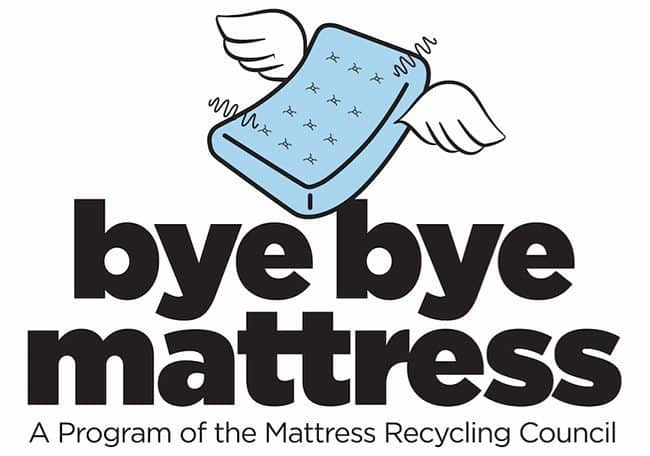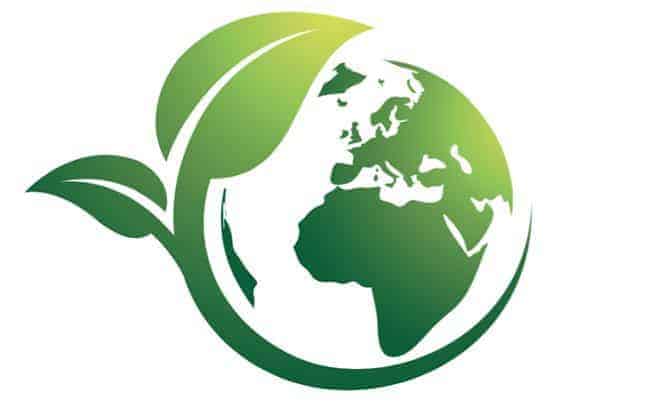Twenty months. Three statewide, sustainable mattress-recycling programs. One million-plus beds kept out of landfills. It adds up to a winning combination.
BY JULIE A. PALM
Three new statewide recycling programs in California, Connecticut and Rhode Island have recycled more than 1 million mattresses and box springs in less than two years—a significant achievement for the mattress industry.
The accomplishment also is a big win for consumers, who now have a no-cost way of disposing of their old mattresses; a relief to states and municipalities that are keeping bulky items out of their landfills; and helpful to companies that use the recycled components and materials to make entirely new products, say officials with the Mattress Recycling Council, a nonprofit organization that developed and now manages all three recycling programs in accordance with the laws in those states.

Like many mattress manufacturers, Richard Diamonstein generally is wary of new government regulations on business, but the industry veteran also has seen the need for better mattress disposal options, both through his role as managing director of Paramount Sleep, a mattress manufacturer based in Norfolk, Virginia, and through his longtime involvement in ISPA, which has a history studying and promoting mattress recycling solutions.
When lawmakers in Connecticut and the other two states began considering mattress recycling legislation, it gave the mattress industry an opportunity to shape regulations that would benefit all stakeholders, says Diamonstein, who now serves as MRC chair.
“The approach we’ve taken when we’ve seen that there’s going to be inevitable regulation is to take a leadership role and work with the states, sending a message that we want to come up with a solution that works for all of us—manufacturers, retailers, regulators, residents, consumers, ” Diamonstein says.
All three states passed their mattress recycling laws in 2013. Connecticut’s program was the first to launch in May 2015, California’s followed in December 2015 and Rhode Island’s kicked off in May 2016.
Although there are some differences between them, the programs operate in much the same way: Consumers pay a fee (ranging from $9 to $11, depending on the state) on every mattress and box spring sold and that money is then used to pay for transporting and recycling the discarded mattresses. Fees appear as a separate line item on a customer’s receipt or invoice.
The consistency across the three states was intentional. The mattress industry, first through ISPA and then through MRC when it was formed in 2013, worked with lawmakers and regulators in California, Connecticut and Rhode Island to craft laws that would not only reduce the flow of mattresses into landfills but also spare retailers, manufacturers and other stakeholders—especially those operating in more than one of the states—from having to deal with a confusing mishmash of regulations and requirements.
Chris Hudgins was one of the ISPA and MRC staff members who worked closely with lawmakers and regulators in each state, as well as industry stakeholders, to draft the recycling laws. He acknowledges “there was skepticism about whether the programs would be workable, let alone successful, from almost everyone in the beginning.”
“One big fear from retailers and manufacturers was that the new fees were going to drive down mattress sales, but we don’t see any evidence of that. Consumers understand why they are paying the fee upfront and appreciate that they can recycle their used mattress at the end of its life at no additional cost,” says Hudgins, who is vice president of industry and external affairs for MRC and vice president of government relations and policy for ISPA.
From old beds to new products
Used mattresses and box springs enter the recycling process in several ways. State residents can drop off their old beds at no cost at participating collection sites or recycling facilities—an arrangement that not only cuts down on the dumping of mattresses along roadsides and in vacant lots, but one that saves residents in a state like Rhode Island (where the previous cost of disposing of a used mattress set could run as high as $50) a significant chunk of change. Of course, many retailers regularly pick up used bedding at customers’ homes when they deliver new mattress sets. Under the state programs, retailers (and manufacturers who sell directly to customers, say through online or contract channels) can either take those pieces to MRC-contracted recyclers themselves or store them until they accumulate a certain number, at which time MRC will pay to transport them to a recycling facility—either way there’s no cost to the retailer (or manufacturer) for recycling. Hotels/motels, colleges/universities, hospitals, military installations and other organizations that may have large numbers of used mattresses can use the same no-cost options as retailers.
“We expect the number coming from retailers and similar sources will increase over time and the numbers at drop-off locations to decrease as people get rid of their ‘legacy mattresses’ (those sitting in people’s basements and garages),” says Mike O’Donnell, managing director of MRC. “We’d prefer to have retailers and other sources intercept mattresses before they enter the solid-waste stream because they tend to be cleaner and in better condition, allowing recyclers to recycle more of the components.”
In Connecticut, the state’s recycling program already is meeting many goals, including the percentage of materials in used mattresses that is able to be reclaimed and sold to other companies for use in new products, says Justine Fallon, New England program coordinator for MRC. (To read MRC’s annual report for the Connecticut program, visit http://bit.ly/2gZcSET.)
“In just its first year, about 80% of the components and materials from the 150,000 mattresses collected and dismantled were recycled,” Fallon says. That figure bests the goal of 75%.
“We’ve taken these mattresses and kept them out of the waste stream and recycled materials into new products,” Fallon adds. “That’s a great environmental story for the product and its long-term value as the used components find new life as raw materials for new products.”
Spreading the word
As with the launch of any new program, particularly one mandated by law, there were questions and even concerns from mattress retailers, manufacturers and others in the industry about exactly how these programs would work. With that in mind, MRC made education and outreach priorities from the start. Its efforts in advance of each state program’s launch were intense and they continue. MRC staff members have made presentations at dozens of mattress and furniture industry events, including the Las Vegas Market and ISPA EXPO, as well as to meetings of waste haulers and recyclers.
New information and regular updates about each state program are reported on the MRC website, the MRC’s consumer-facing website, in MRC and ISPA newsletters, on MRC social media channels and, of course, in the pages of BedTimes and its sister publication, Sleep Savvy, says Amanda Wall, marketing and communications coordinator for MRC. MRC staff members also are in direct contact with manufacturers, retailers and other stakeholders through letters, emails and phone calls—whatever it takes to get the word out
“Just because the programs have launched, MRC outreach hasn’t stopped,” Wall says.
Making sure consumers understand the fee also is critical to the success of the mattress recycling programs. The ByeByeMattress.com website is user friendly and filled with the latest recycling information for each state. In addition, MRC staff members reach out to consumers through public service announcements, paid advertising, social media, and attendance at events like Earth Day festivals and Keep America Beautiful’s America Recycles Day.
“People like to participate in recycling and feel good about it,” Fallon says. “And to be able to recycle their old mattresses through no-fee recycling by having them picked up by a retailer or taking them to a drop-off site is a win-win for them.”
MRC is independent and strong
And speaking of wins, MRC’s success in creating three functional, complex organizational structures in three very different states, contracting with recyclers in those states, educating retailers and manufacturers about their requirements under the laws, marketing the recycling programs to consumers, and doing it all in a financially sustainable way has been a big victory for the mattress industry and MRC.
“It’s been a phenomenal success,” Diamonstein says. “There were so many uncertainties at the beginning and our fear of the unknown helped drive us to be cautious in setting up the right type of internal organization and structure and to be conservative to make sure the programs work and can be ramped up as needed.”
As Catherine Lyons points out, it’s important for the industry to understand that while there are staffing overlaps between the two entities—she herself serves as ISPA senior vice president, MRC chief financial officer and secretary/treasurer of MRC’s board—MRC and ISPA are separate organizations. MRC has repaid an initial setup loan that was secured by ISPA’s headquarters building as collateral and has been a financially self-supporting entity since early 2016, she says.
“Financially, we are positioned to meet the needs of each state program, to have a reasonable reserve and to support the ongoing needs of the programs on an annual basis,” Lyons says.
Diamonstein points to O’Donnell’s past experience with other industries’ recycling efforts and his early input into the structuring of MRC as critical to the success of both the organization and the three statewide programs. MRC also has assembled a strong team of about a dozen staffers split between the three states and the headquarters office in Alexandria, Virginia.
“At the end of the day, the impact of these programs is very positive,” Diamonstein says. “As a manufacturer, I’m always concerned about regulation but we’ve shepherded through good programs. It is part of our social responsibility to help find solutions to the problem of used products going into landfills and (the statewide recycling) programs are a solution for something that’s always been a problem. It puts our industry in a very positive light.”
A wealth of resources
The Mattress Recycling Council has a robust “Resources” section on its website where you’ll find registration guidelines, FAQs, an informational video series, guides to answering consumer questions, ready-to-use consumer-education materials and much more.

Manufacturer responsibilities
Register as a manufacturer.
Under the state laws, mattress manufacturers whose products are sold in California, Connecticut and Rhode Island must register with the Mattress Recycling Council. In California, retailers are required to sell mattresses and box springs only from registered producers. The California law includes an additional provision that requires MRC to provide monthly a list of registered manufacturers and the brands/products they sell in that state to California’s Department of Resources Recycling and Recovery (better known as CalRecycle).
Register and report your mattress and box spring sales if you sell products directly in California, Connecticut or Rhode Island.
If you are a mattress manufacturer that sells mattresses and box springs directly to consumers in California, Connecticut or Rhode Island—say, through your own website or through contract channels such as hotels/motels, colleges/universities, military instillations, etc.—you must register with MRC, collect the fee set by the state on every mattress and box spring you sell, and report and remit those fees monthly to MRC. MRC has worked to make registration, reporting and remittance easy through a portal at MRCReporting.org.
“Remember, a lot of manufacturers are acting as retailers. If you make direct sales to a hotel property and sell 4,000 units, you have to collect and remit the fee just like a traditional retailer does,” says Mike O’Donnell, managing director of MRC, adding that a key to the success of these statewide mattress recycling programs is a level playing field. “Every company that sells mattresses and box springs needs to participate. And that includes online retailers that ship products to consumers in one of the three states in which we operate. There are no ‘free riders.’ It’s important that everybody participates.”
And, thus far, “we’ve had very good compliance with the laws,” says Chris Hudgins, vice president of industry and external affairs for MRC and vice president of government relations and policy for the International Sleep Products Association. “One of the issues some retailers bring up is ‘I’m collecting and remitting the fees but I don’t know if my competitor down the street is.’ But we’ve seen good compliance, even with online retailers.”
Mattress manufacturers and retailers that don’t register or fail to collect, report and remit the mandated fees are subject to financial penalties and could be barred from selling mattress sets in the state. They also must pay all recycling fees they failed to collect initially, retroactive to the day the law when into effect in that state, Hudgins says.
Pay attention to what might be happening in other states—and get involved.
At this point, MRC thinks it’s unlikely that other states will pass mattress-recycling legislation in 2017, Hudgins says. MRC carefully monitors the progress of potential mattress-recycling legislation at the state level and, while ISPA and MRC don’t actively encourage states to start statewide programs, they do work closely with lawmakers and regulators in states that are considering such bills. If new legislation is drafted and introduced, MRC’s goal is to make certain it’s similar to the laws in California, Connecticut and Rhode Island. Industry stakeholders, including manufacturers, are an important part of that advocacy process and are encouraged to get involved. To receive news about proposed mattress recycling legislation in your state and other recycling matters, sign up for MRC updates.
CalRecycle making inspections to check compliance. Be ready!

Inspections include site visits to retailers, wholesalers, distributors, importers, renovators, recyclers and manufacturers that distribute, sell or offer for sale mattresses and box springs to California consumers. Visits are conducted at random throughout California.
The Mattress Recycling Council offers this list of information requested during these inspections and tips for how you can prepare:
- Proof of registration: The email you received when you created your MRCReporting.org account is sufficient proof of registration with MRC. Keep in mind that you have separate emails for each state and role you applied for. If you registered on behalf of multiple locations, be sure to distribute a copy of your documentation to each one.
- Proof of fee collection: You will be asked to show that the recycling fee is a separate line item on a receipt or invoice.
- Proof of remittance: A history of your submitted remittance can be found in the “Submitted Reports” area of the “Reporting” tab in your MRCReporting.org account. If you are reporting on behalf of multiple locations, you should distribute a copy of your documentation to each one. To assist you and CalRecycle, the report submission confirmation screen will remind you how to recall and save this information.
- Proof of registration of brands and Uniform Registry Numbers: CalRecycle requires manufacturers to supply lists of all brands and Uniform Registry Numbers they sell in the state to MRC and those lists are posted at CalRecycle.ca.gov/Mattresses. Products made by an unregistered manufacturer or that carry an unregistered brand or URN cannot be offered for sale.
- The used mattress unit pickup requirement: If you deliver new mattress units to customers, California law requires you to pick up used mattress units for recycling, at no additional cost to the consumer or customer. Some exceptions apply. (For example, if delivery is made by common carrier.) CalRecycle will ask what pickup services you offer.
Once the visit is completed, CalRecycle will send a report to the inspected location. If violations are found, CalRecycle can impose penalties up to $5,000 per day.
Questions about your inspection? Contact CalRecycle at [email protected] or call 916-341-6192. For information about MRC, contact Amanda Wall, MRC marketing and communications coordinator, at [email protected].
By the numbers
California
- 39.5 million: Approximate population
- 1 million: Goal for number of mattresses recycled annually, with unit collection increasing over time
- 7: Number of recyclers contracted by the Mattress Recycling Council (with 11 processing facilities total)
- $11: The fee collected when a mattress or box spring is sold to California consumers
Connecticut
- 3.5 million: Approximate population
- 150,000: Goal for number of mattresses recycled annually
- 3: Number of MRC-contracted recyclers
- $9: The fee collected when a mattress or box spring is sold to Connecticut consumers
Rhode Island
- 1 million: Approximate population
- 65,000: Goal for number of mattresses recycled annually
- 2: Number of MRC-contracted recyclers
- $10: The fee collected when a mattress or box spring is sold to Rhode Island consumers






